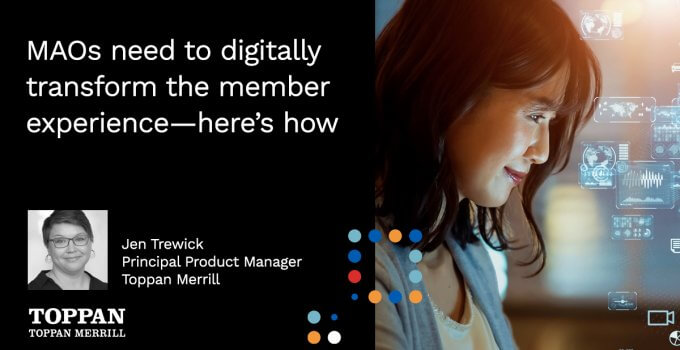Medicare Advantage (MA) now presents payers with the biggest opportunity in the healthcare market, and true to classic market theory, we’re seeing competition heat up: more payers offering more plans, contending for more patients. Over half of all Medicare-eligible Americans are now enrolled in an MA plan, and the typical Medicare beneficiary now has 43 different MA plans to choose from, representing more than 100% growth in the last five years.
As payers look for ways to stand out to beneficiaries, it’s not just about what they say — it’s where they say it. We’ve seen a major shift in preferences and expectations among today’s digital-savvy Medicare population. And while we’re already seeing payers change how they advertise — moving toward digital channels — that digital transformation needs to expand to include the entire member experience — from how Medicare Advantage Organizations (MAOs) onboard members and promote engagement with how they empower them to digitally manage their benefits and care.
Beneficiaries’ digital expectations rising rapidly
As more than 10,000 Baby Boomers age into Medicare eligibility every day, these beneficiaries bring expectations formed through their lives as digital consumers. A recent McKinsey survey showed beneficiaries rank email, TV and online ads as the most informative — far above traditional channels.
But it’s not just advertising — they expect the same kind of self-service, digital-first buying journey that they get from the best consumer brands. They want to manage “stealth shopping” on their own, rather than get a call from a sales rep. They’re going directly to payer websites or using brokers’ online tools to find plans — and even CMS is actively investing in improving its web tools to help beneficiaries navigate their options.
More than Medicare Advantage customer acquisition: extending the member experience
Increased competition is driving media spending way up for MAOs. McKinsey’s report showed digital advertising growing by a whopping 33% year-over-year, while conventional channels like print (magazines and newspapers) continue a steady decline. Notably, MAOs are still seeing success with direct mail, as evidenced by increased annual spending in that channel.
But higher spending means higher customer acquisition costs, and payers can’t afford to let hard-earned members defect after a year or two. Retention will continue to be a top priority for MAOs in 2024 and beyond.
The key to successful retention centers on digitally reinventing the entire Medicare member engagement experience. Payers must deliver the useful information and guidance that beneficiaries want — with the digital convenience they expect. They need to give members the empowering self-service feeling of digital communications and on-demand digital access. Doing it right will help drive loyalty and create a flywheel of momentum: Delivering digitally enhanced member experiences will help MAOs retain the members they’ve worked (and spent) to earn; those experiences will power higher quality scores with CMS’ new criteria that heavily weigh member experience; and those stand-out quality scores will do more of the heavy lifting of acquisition and net-new growth.
Digital onboarding must become standard
It’s clear that beneficiaries want a digital experience when shopping for the right MA plan. But they don’t want that modern experience to end the second they sign up. Empowering omnichannel convenience should continue with digital onboarding delivered via email, online portals, mobile apps, etc.
MAOs are definitely making progress in this regard, but a different McKinsey study showed there’s still a huge opportunity for digital leaders: Most current MA plan members are not satisfied with the digital onboarding experience.
As MAOs make the shift toward digital onboarding, meeting Medicare communications and marketing guidelines must not be overlooked. Print materials cannot be entirely abandoned. Rather, they need to strike the right balance between meeting regulatory requirements around print materials (Annual Notice of Changes, etc.) with making these onboarding resources conveniently accessible, on-demand, through multiple digital channels.
Using data — in a HIPAA-safe way — to personalize digital experiences
Another expectation carried over from beneficiaries’ broader lives as modern consumers: They want communications and digital experiences to feel customized to them. After all, a big appeal of MA plans is the ability to select a plan that offers both core and ancillary benefits that uniquely suit their health needs and their lifestyles.
Today’s beneficiaries are shrewd digital audiences, and they see right through generic messaging. But they’re increasingly comfortable with the implicit trade-off in the personalization game: They’ll share their personal data, but they expect MAOs to use it to deliver a value-added experience.
This personalization should start with the digital onboarding experience. Payers need to do much more than print the member’s name and address at the top of a packet of print materials. The details of the onboarding materials and the entire experience should feel curated for that individual — their selected plan and the benefits they’re most likely to need and use.
Of course, regulations around the use of protected health information (PHI) and other personal information grow tighter seemingly by the day. So, it will be paramount that MAOs seek out the technologies and partners that enable them to build and execute a data-driven, digital-first onboarding and engagement program that’s able to harness member data in a privacy-safe, HIPAA-compliant way.
The winners of tomorrow’s MA market will focus on member engagement over net-new acquisition
As with any market seeing surging growth and intense competition, marketing spend is skyrocketing within most MAOs. Payers are recognizing beneficiaries’ digital-first preferences, using new marketing tools to drive more targeted digital campaigns. But as CMS tightens the reigns on Medicare marketing, marketers see the potential of advanced digital strategies significantly limited. Moreover, savvy payers recognize that focusing on member engagement and retention provides a higher bang for the buck — not only driving renewals but boosting quality scores to create self-sustaining net-new growth.
Yet the gap between members’ digital expectations and the reality of MA member experiences remains a wide-open opportunity: Those payers that can most rapidly embrace the digital transformation of onboarding and empower members with digital-first ways to manage their benefits will organically rise to the top of this rapid growth marketplace.
See how Toppan Merrill is helps MAOs accelerate digital transformation
Toppan Merrill has been helping some of the most innovative and successful insurance organizations to evolve their member engagement strategies to stand out in an age of rising expectations. Learn how Toppan Merrill works alongside Medicare marketing teams to help them create omnichannel experiences that combine hyper-personalized printed materials with highly accessible, self-service digital resources — all while balancing ever-changing and ever-tightening regulatory requirements to ensure compliance and audit-readiness.



